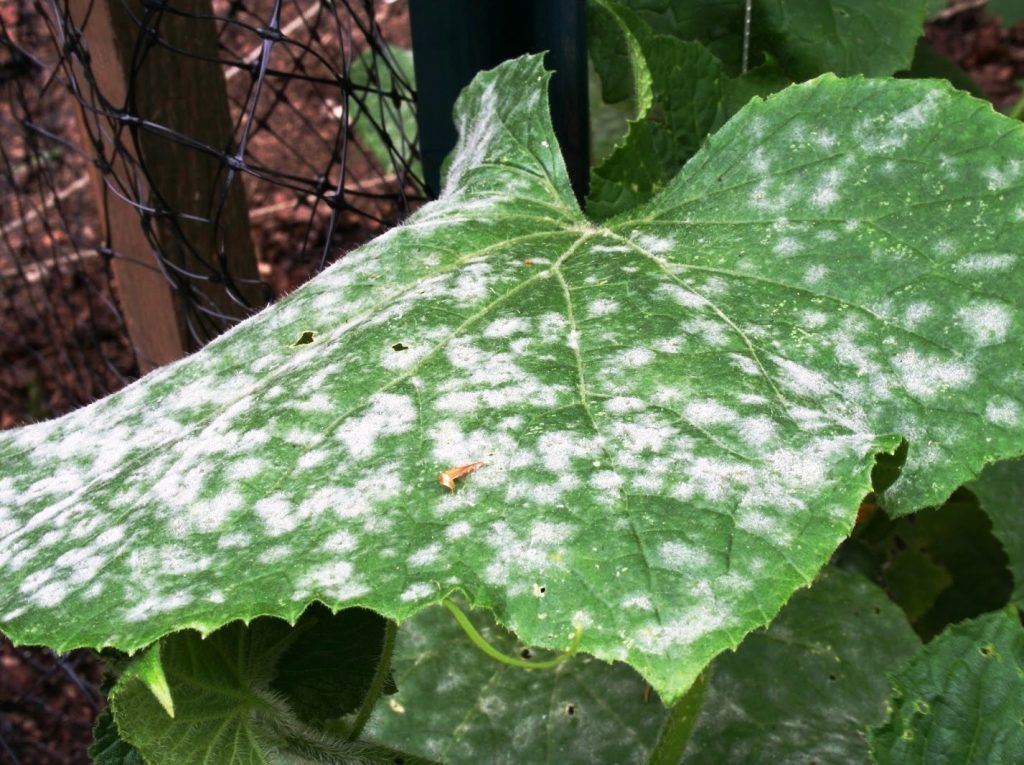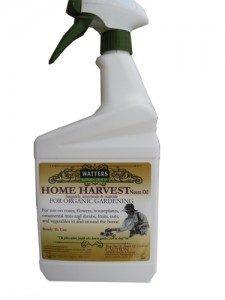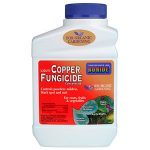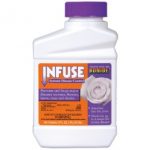by Ken Lain, the mountain gardener

Powdery mildew is one of the most prevalent and recognized plant diseases of our rainy season, July to the end of October. Virtually no plant is immune, but some are more susceptible than others. Lilacs, crab apples, phlox, monardas, roses, grapes, squashes, and cucumbers are likely targets for this powdery pest.
Recognizing Powdery Mildew – Take a close look at this photo of a squash leaf in my garden. Powdery mildew looks like powdery splotches of white or gray on the leaves and stems of plants. There are several types of powdery mildew fungi, but they all look the same. You may not notice a problem until the top surfaces of the leaves turn powdery, but powdery mildew can also affect the lower leaf surface, stems, flowers, buds, and even the fruit of a plant.
Although powdery mildew is unattractive, it rarely is fatal. It does stress the plant, and severe or repetitive infections will weaken a plant’s health. If enough of the leaf surface becomes covered with powdery mildew, photosynthesis is impaired. Infected leaves often drop prematurely. This can be a particular problem on edible crops since insufficient photosynthesis can diminish the flavor of the fruit or vegetable. If buds become infected, they may not open and mature at all.
Mildew is Host Specific – Powdery mildew fungi are host specific, meaning the different powdery mildew fungi infect different plants. The powdery mildew on your lilacs will not spread to your grapes or your roses. However,
Cause and Effect – Powdery mildew fungi seem to be everywhere. They overwinter in plant debris, and begin producing spores in the spring. These spores are carried to our plants by wind, birds, insects, and splashing water. All powdery mildews thrive in the same conditions. The growth and spread of powdery mildew is encouraged by dampness, high humidity, poor air circulation, and crowded plants in the garden. In the mountains of Arizona, all these conditions appear at the start of our monsoon season.
Controls – First and foremost choose healthy plants from your garden center. Healthy plants are less likely to become diseased and are able to better fend for themselves once an attack happens. Good to know that plants are being bred that are more resistive to mildew. Whatever you do, don’t plant non-resistant varieties in shaded areas with poor air circulation!
Infected Plants – Just a little work will fend off pesky powdery mildew. Remove and destroy all infected plant parts, especially yellow leaves and those that are mostly covered by the white spores. Because powdery mildew favors young, succulent growth, don’t fertilize until the problem is corrected. Try to water infected plants at ground level to keep leaves as dry as possible. Spray the entire plant from top to bottom with a good fungicide.
Fungicides simplified – For continuous protection, most fungicides will need repeat applications every 7 – 14 days. Always follow the label instructions for both implementation and the waiting period before harvest.
Organic controls – Early detection and prevention are best done with Watters ‘Home Harvest’ organic spray.  Spraying an infested plant with this neem based liquid not only kills that spore and prevents spread, it also eliminates small insects like aphids, thrips, and mealybugs.
Spraying an infested plant with this neem based liquid not only kills that spore and prevents spread, it also eliminates small insects like aphids, thrips, and mealybugs.
Edibles coated in white mildew will need something stronger. Clean up yellowed, infected leaves of fruit and vegetable plants as best you can; then spray with 100% organic ‘Copper Fungicide’. It may be applied moments before harvest.
infected leaves of fruit and vegetable plants as best you can; then spray with 100% organic ‘Copper Fungicide’. It may be applied moments before harvest.
Seriously infected plants need Bonides ‘Infuse’ , the most powerful fungicide you can buy over the counter. Use it on plants like roses, lilacs, vincas, and privets for quick relief. Be aware that it is not rated for garden edibles.
plants like roses, lilacs, vincas, and privets for quick relief. Be aware that it is not rated for garden edibles.
Spray at least every other week until new leaves emerge clean and disease free. At this stage feed your plants and they should take off with new growth.
If you just aren’t sure, consult one of the plant experts here at Watters Garden Center.
All products mentioned in this article are available here at the garden center with experts to direct their use.
Please – Powdery mildew spreads very easily to other plants. If you are bringing a leaf sample with you, place it in a ziplock bag or a jar to contain the spores and prevent spreading here at the garden center. Thank you.
See samples of Powdery Mildew from local gardens on Watters Pinterest Board, Follow our board for local updates.
Until next week, I’ll be helping local gardeners here at Watters Garden Center.
Ken Lain can be found throughout the week at Watters Garden Center, 1815 W. Iron Springs Rd in Prescott, or contacted through his web site at WattersGardenCenter.com or FB.com/WattersGardenCenter .

